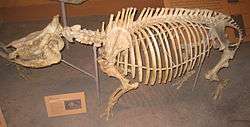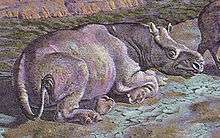Trigonias
This article is about the extinct rhinoceros. For the bivalves, see Trigoniidae.
| Trigonias Temporal range: late Eocene[1] | |
|---|---|
 | |
| T. osborni | |
| Scientific classification | |
| Kingdom: | Animalia |
| Phylum: | Chordata |
| Class: | Mammalia |
| Order: | Perissodactyla |
| Family: | Rhinocerotidae |
| Genus: | †Trigonias Lucas, 1900 |
| Type species | |
| †Trigonias osborni | |
| Species[2] | |
| |
| Synonyms | |
| |
Trigonias is an extinct genus of rhinoceros from the late Eocene (Chadronian) some 35 million years ago of North America (Prothero, 2005).

Restoration by Jay Matternes
It is the oldest rhino of which is still alive. Trigonias was about 2.1 m (7 ft) long and, despite lacking horns, looked a lot like modern rhinos. Its front legs had five toes (as contrasted with three in modern rhinos), the fifth of which was vestigal.[4]
A specimen of T. osborni was estimated to have a weight of about 391.4 kg (862.9 lbs).[5]
Notes
- ↑ Prothero, 2005, p. 184.
- ↑ Prothero, 2005, pp. 35-37.
- ↑ Prothero, 2005, p. 35.
- ↑ Palmer, D., ed. (1999). The Marshall Illustrated Encyclopedia of Dinosaurs and Prehistoric Animals. London: Marshall Editions. p. 264. ISBN 1-84028-152-9.
- ↑ http://paleodb.org/cgi-bin/bridge.pl?a=basicTaxonInfo&taxon_no=52444
References
- Prothero, Donald R. 2005. The Evolution of North American Rhinoceroses. Cambridge University Press, Cambridge, 218 pp. ISBN 0-521-83240-3
This article is issued from Wikipedia - version of the 6/30/2016. The text is available under the Creative Commons Attribution/Share Alike but additional terms may apply for the media files.